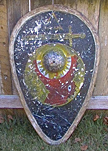Edging a shield
A lot of what I talk about here is the cumulation of years of shield edge tinkering and thinking. Originally, I used flat wooden shields with aluminum u-channel, heater hose edging. Nylon cording laced the whole thing together. There has been a lot of evolution from that starting point.
I went through a lot of trial and error to make the edges on my plywood shields durable. Eventually, I ended up with edges that out-lived the plywood. This meant that I now had to figure out how to make my shields last as long as my edges.
When aluminum shields became popular, I resisted switching because I found that the edging on metal shields died at an alarmingly fast pace. The last thing I wanted was a high maintenance shield. Unfortunately, I had reached the point where the plywood was the weakest part of my shield. The only real option was going to aluminum, which meant that I had to overcome the problem of edge deterioration.
Part of my solution was using rawhide. Rawhide is tough, but it eventually cuts where it pinches between the edge of the shield and the rattan that strikes it. So, I had to figure out how to thicken the edge of the shield. I tried plastic car door edging, and found that it died really quickly. I tried building up the edge with paper maché made with wood glue, and found that the layers of paper and glue powdered after a few practices I switched to using fabric and wood glue, which died just as quickly. I toyed with the idea of using carbon fiber resin, but shelved it as it would probably be very expensive.
What I had to do was use a metal channel. Adding metal u-channel to a shield not only makes the edge THICKER, it rounds the edge, which lessens damage to the rawhide outer layer and the rattan that hits it. It also makes the shield heavier, which has its pluses and minuses. On the minus side, it's harder to get moving. On the plus side, it moves less when it gets whacked. In general, I've found that aluminum shields need more mass - especially gripped shields, which torque easily when hit.
I could not find any off the shelf metal u-channel that met my specs. I could order a flexible metal cored car-door edging, but I figured that the rubber would die leaving sharp little bits of metal floating between my shield and the rawhide.
The solution was to build my own u-channel. To do this, I went out and bought some scrap 18 guage strips of stainless steel. I found it at Bataeff's salvage yard in Santa Rosa. I needed strips that were about an inch and a half wide. The ones I found were three inches wide, so I had to do was cut them lengthwise. Since I don't own a Beverly Shear, I used a pair of big metal shears and a lot of muscles.

